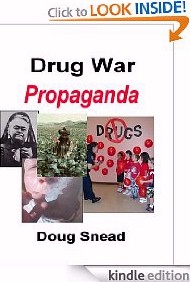NIDA: Themes in Chemical Prohibition, William L. White, 1979
http://www.druglibrary.org/schaffer/History/ticp.html
2. The Drug is Identified as
Solely Responsible for Many Problems in the Culture, i.e.,
Crime, Violence, Insanity.

|
|
''Hopelessly and incurably insane,
a condition caused by the drug
marihuana'' -
Reefer Madness
|
|
The attributing of crimes of violence, sexual assault,
insanity, moral decay, etc. have been an integral part of
efforts to prohibit the currently illicit drugs. A key element
in this theme is the arbitrary designation of
"good" and "evil" drugs with
evil drugs possessing powers that can overwhelm all efforts at
human control.
"The
Devil made him do it"
is changed
to "the drug made him do it." This aspect of
prohibitionist philosophy is so often reported, there is no need
to belabor the point. A few illustrative examples will be
outlined.
|
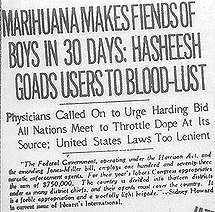
A prohibitionist movement, which was short lived but quite
capable of attributing the evils of the world and the
devastation of human beings to its particular despised chemical,
gave wide circulation to a statement by Sir Clifford Allbut,
M.D. and Walter Dixon, M.D. which appeared in A System of
Medicine in 1909. At the time Sir Clifford was a professor of
internal medicine at the University of Cambridge in England and
Dr. Dixon was a professor of pharmacology at Kings College in
London. An excerpt follows:
The substance referred to is
coffee,
and the statement was
circulated for a short time in an attempt to garner support for
the prohibition of coffee.
The anti-tobacco forces were much better organized (with
cigarettes still illegal in 14 states in 192121, and their
pronouncements received wide distribution. The following
statements are representative of those used by the anti-tobacco
forces from 1920 to 1935, Louis Lewin, an eminent authority on
pharmacology, wrote the following in 1924 which received wide
distribution:
|
The juvenile female flower of the nation, the 'Emancipata
femans vulgaris' (Lewin's term for the feminists of his day)
who should bear fruit in time to come. . frequently fails to
do so because the foolish consumption of cigarettes has
impregnated the sexual organs with smoke and nicotine and
keeps them in a state of irritation and inflammation.
22
|
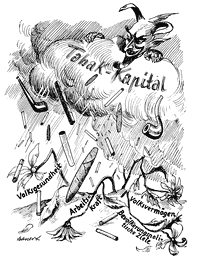
Few today remember the anti-tobacco campaigns of the Nazis
|
A 1930 issue of the National Advocate reported a doctor's
opinion that "Sixty percent of all babies born of mothers
who are habitual smokers die before they are two years
old."23 An anti-tobacco publication of
1931 included the following:
|
Fifty percent of our insanity is inherited from parents
who were users of tobacco; sometimes the victim is a smoker
himself, which hastens it on. Thirty percent of insanity
cases are caused directly from cigarette smoking and the use
of tobacco. . . 24
|
Several anti-tobacco publications of the 1920's quoted New
York City Magistrate to illustrate the crime producing
properties of tobacco:
|
Ninety-nine out of a hundred boys between the ages of 10
and 17 who came before me charged with a crime have their
fingers disfigured by yellow cigarette stains. 25,26
|
Tobacco was also reported to be the hidden cause of increased
suicides in the early 1900's:
If we
look
at the few years preceding passage of the Marijuana Tax Act in 1937,
we see equally vociferous statements
on the evils and destructiveness of marihuana. An advertisement
distributed by the Federal Bureau of Narcotics in 1935 read as
follows:
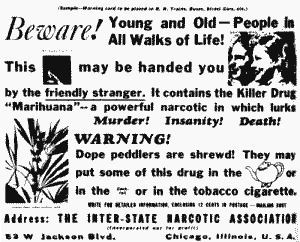 Beware! Young and Old -- People in All Walks of Life! This
(picture of a marijuana cigarette) may be handed to you by
the friendly stranger. It contains the Killer Drug
'Marijuana' - a powerful narcotic in which lurks Murder!
Insanity! Death! 28
Beware! Young and Old -- People in All Walks of Life! This
(picture of a marijuana cigarette) may be handed to you by
the friendly stranger. It contains the Killer Drug
'Marijuana' - a powerful narcotic in which lurks Murder!
Insanity! Death! 28
In 1936 the International Narcotic Education Association in
conjunction with the Federal Narcotics Bureau published
Marihuana or Indian Hemp and Its Preparations which included
statements such as:
Prolonged use of marihuana frequently develops a delirious
rage which. . . sometimes leads to high crimes such as
assault and murder. Hence marihuana has been called the
'killer drug.' The habitual use of this narcotic poison
always causes a very marked deterioration and sometimes
produces insanity. Hence marihuana is frequently called
'loco weed.' . . Marihuana often gives man the lust to kill
unreasonably without motive. Many cases of assault, rape,
robbery, and murder are traced to the use of marihuana.
29
[see also]
Such reports were not limited to the Federal Bureau of
Narcotics. An article in the 1936 March issue of Scientific
American included the following:
|
Marijuana produces a wide variety of symptoms in the user,
including hilarity, swooning, sexual excitement. Combined
with intoxicants, it often makes the smoker vicious, with a
desire to fight and kill. 30
|
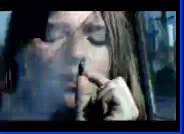
|

Modern prohibitionist propaganda employs
time-tested technique and imagery.
In this 2006 ad, parents are informed that marijuana kills.
Compare with similar scenes from "Reefer Madness", 1936.
[government anti-drug PSA, "Rewind", Mediacampaign.org
Real Movie,
AVI
]
|

|

Scenes from "Reefer Madness", 1936.
A puff of marijuana leads to the death of the young and innocent Mary Lane.
|
|
|
U.S. Congressman Mark Souder insists that marijuana kills, 2007:
| |
Tucker Carlson: ... and how many people died from marijuana overdoses last year?
Rep. Mark Souder (R-IN):
If you count the amount of crime associated with marijuana...
Carlson: No, no, just marijuana overdoses. Just the drug itself, which you said is like cocaine now. How many people died from it?
Souder: I don't... 65 percent of emergency room admissions for drug abuse are marijuana.
Carlson: But did anyone die that you know of?
Souder: Presumably so, thousands have died, the only question is, you said "overdose" --that isn't even most of the deaths related to prescription drug or to cocaine or heroin -- there's a whole range of drug crimes and so on. I don't know the number of overdoses.
Marijuana is often managed, with meth -- no drug user is a single drug user so marijuana is often in the mix of most deaths so it would be very hard to separate what's what. A marijuana user is very seldom just a casual marijuana user (except in the early stages). They're often go[ing to be]
polydrug [abusers].
[source: Drug WarRant, Feb. 2007]
|
|
Up until the end of prohibition of alcohol in 1933, there was
a great deal of overlap between those participating in various
prohibitionist movements. All of these persons and groups shared
an anti-hedonistic ethic which provided a united front
politically in their efforts to legally prohibit all
pleasure-producing chemicals as well as other pleasurable
nonchemical pastimes of humans, i.e.,
dancing,
jazz
music,
gambling,
etc. The years following the end of alcohol
prohibition saw the beginning distinctions between good drugs
and evil drugs. Those drugs within the experience of the
majority of Americans were considered good; those drugs which
tended to be used by minority and fringe groups tended to be
defined as evil. Thus alcohol, nicotine, and caffeine (coffee)
began to become increasingly integrated into the very fabric of
American life, whereas cocaine, opium, heroin, and subsequently
marihuana and the hallucinogens continued to be defined as evil
- physically, emotionally, and morally devastating to the
individual and unquestionably destructive to the culture. This
definition of certain chemicals as innately good or evil was to
germinate from 1933 into the 1960's where we would witness a
giant eruption of this issue as adult America was forced
to attempt to articulate to their own children the culturally
inherited
distinction between good drugs (alcohol) and evil
drugs (marihuana, etc.).
|














